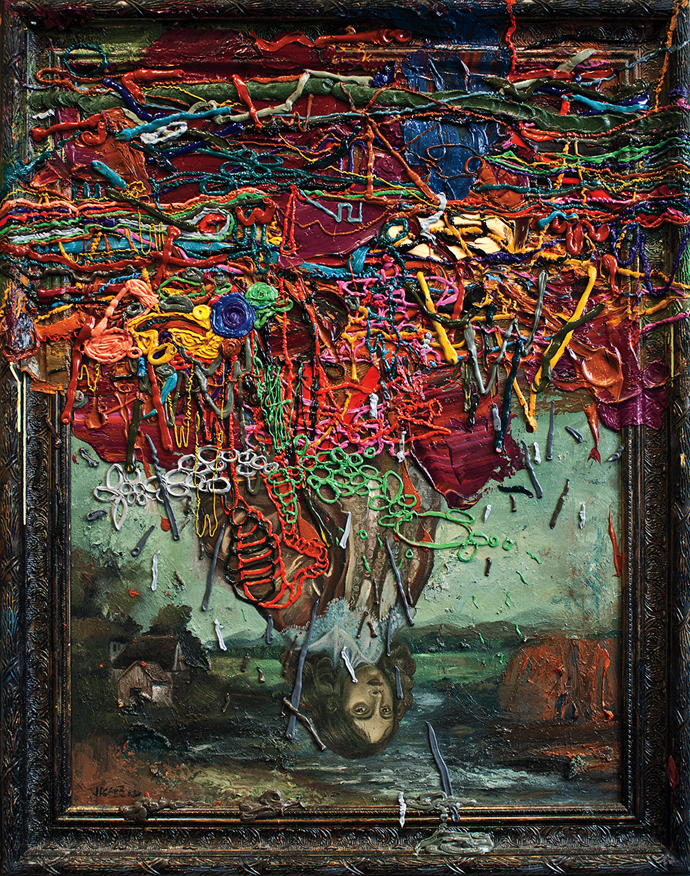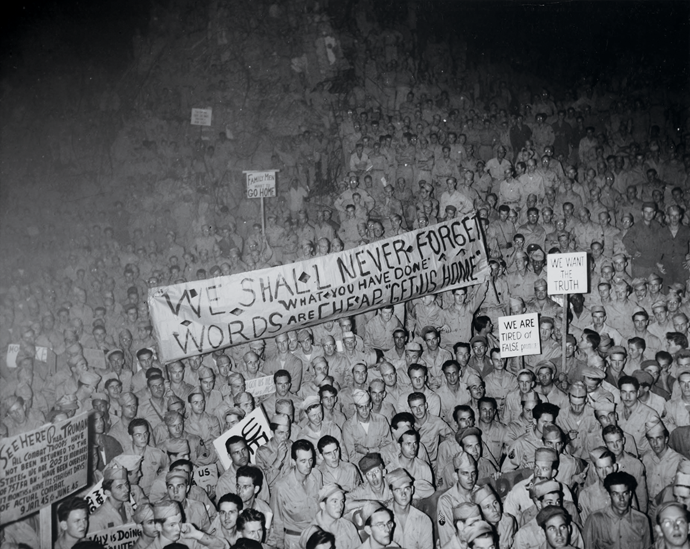Discussed in this essay:
How to Hide an Empire: A History of the Greater United States, by Daniel Immerwahr. Farrar, Straus and Giroux. 528 pages. $30.
Lost Children Archive, by Valeria Luiselli. Knopf. 400 pages. $27.95.
Territory of Light, by Yuko Tsushima. Translated by Geraldine Harcourt. Farrar, Straus and Giroux. 192 pages. $23.

Philippine Islands ten-peso silver certificate, 1903, from How to Hide an Empire: A History of the Greater United States, published this month by Farrar, Straus and Giroux. Courtesy Farrar, Straus and Giroux/The Library of Congress
How might an imperial power see itself? In Hons and Rebels, Jessica Mitford recalls the geography lessons she and her sisters received in the 1920s from their formidable matriarch, known as Muv: “See, England and all our Empire possessions are a lovely pink on the map,” she would trill. (Germany was “a hideous, mud-colored brown.”) Take, by contrast, the following tidbit from the Northwestern University historian Daniel Immerwahr’s fascinating new book, How to Hide an Empire: A History of the Greater United States (Farrar, Straus and Giroux, $35). An adult and a child encounter each other on the streets of Manila near the end of World War II. Handing out candy and cigarettes, the man, a GI, patiently enunciates his words, before finding, astonished, that the kid speaks perfect English. When he asks, “How’d ya learn American?” the answer—all schools in the US-colonized Philippines teach in English—doesn’t help much, since it seems that no one bothered to tell the soldier he’s serving on US soil. All this time, Immerwahr wryly concludes, he “thought he was invading a foreign country.”
The anecdote encapsulates Immerwahr’s aim, which is to restore the US territories—totaling, in the mid-1940s, about an eighth of the population and a fifth of the land mass of the so-called greater United States—to their proper place in history and consciousness. His book’s “main contribution is not archival [but] perspectival,” and it is consistently both startling and absorbing. Correcting the common impression of a US imperial moment that flowered only briefly in the years after 1898, he shows how empire was in fact foundational to the American national project (the country started acquiring land overseas in the 1850s, only a few years after fixing the boundaries of the contiguous states), how central it remains, and how, among empires, this one has all along been uniquely ignored by its mainland citizens. Immerwahr vividly retells the early formation of the country, the consolidation of its overseas territory, and the postwar perfection of its “pointillist” global empire, which extends influence through a vast constellation of tiny footprints—its approximately eight hundred military bases across scores of nations, dwarfing the twenty or so held by France, Russia, and my pretty-in-pink motherland combined.

Remix I (Diptych), by Jigger Cruz (detail) © The artist. Courtesy Primo Marella Gallery, Milan.
Much of this book’s power is in the details. There’s a hilarious series of telegrams sent by a covert CIA operative from the Swan Islands as he plies some Honduran student activists with booze and lets them raise their own flag there (“THESE KIDS ARE GREAT,” he reports fondly, though naturally, Immerwahr notes, a bunch of marines stood by, “ready to start shooting if the beer didn’t work”). And there’s the long and unpleasant history of medical experimentation in Puerto Rico, to which we owe the development of chemotherapy and the contraceptive pill (“How can we get a ‘cage’ of ovulating women to experiment with?” an heiress who funded the trials had wondered). One chapter is titled after the familiar lyric from West Side Story (“Nobody knows in America / Puerto Rico’s in America”), and Immerwahr later reminds his readers that in the wake of Hurricane Maria nearly half the mainland population was still unaware that Puerto Ricans, like them, were citizens.
Frequently given credit as that rare country that voluntarily decolonized itself after a victorious war—granting the Philippines full independence, for instance, in 1946—the United States acted not out of democratic principle but rather because it faced considerable resistance and so, as Immerwahr describes, was obliged to develop, by ingenious means, the more dispersed form of colonialism that exists today. He includes a heartening photo of some of the US troops who had turned out in the tens of thousands—far too numerous to court-martial—in the Philippines, Korea, Guam, and elsewhere to protest their own continuing postwar deployment, in one case burning an effigy of the secretary of war. “What kind of government is this?” one asked. “What are we that scream piously ‘the world must be free,’ then keep it to ourselves?” The built-in denial of colonialism, nearly as old as the colonies themselves, is as much a matter of self-image as of pragmatism—the desire to avoid that pesky word “empire,” which to American ears may seem always to be crying out for the familiar modifier “evil.” Still, for Immerwahr, shame or guilt is somewhat beside the point here. The role played by US colonial outposts is no mere remnant of the past (let’s not forget Guantánamo), and the United States appears to be an entirely different place once you expand its usual map. This is a question of accuracy—of knowing what it is you see when you look in the mirror.

“Twenty Thousand Who Want to Go Home,” a photograph of American soldiers outside Manila’s city hall, January 1946, from How to Hide an Empire: A History of the Greater United States. Courtesy Farrar, Straus and Giroux/The Library of Congress
In Tell Me How It Ends, her non-fiction account of her work volunteering as an interpreter for undocumented Latin American children due to appear in New York’s immigration court, the Mexican novelist Valeria Luiselli describes driving with her own family through the Southwestern states along the US-Mexico border. Her new novel, Lost Children Archive (Knopf, $27.95), is in part a fictional account of a similar trip, following a family as they drive from New York to the Chiricahua Mountains of southeastern Arizona, the mother occasionally reaching out an arm to show her young children how much of the land used to be Mexico. Both the woman and her husband make and edit sound recordings for a living: the trip has been prompted by his desire to research Geronimo and the Apache warriors who were “the last free peoples” on the continent, while she is figuring out how to make a sound documentary about migrant children. On the way, they hear Lord of the Flies on audiobook, alongside radio news reports about the border crisis, and the mother reads aloud from a book of elegies Luiselli has invented out of parts of Conrad, Pound, Eliot, Rilke, Juan Rulfo, and Jerzy Andrzejewski. What emerges from this braiding and reworking of disparate texts is a highly imaginative and politically deft portrait of childhood within a vast American landscape. The parents and their children—one of whom narrates parts of the book—see and imagine the same territory differently, their experiences and those of the young migrants traveling elsewhere in the desert overlapping and separating again to create a kind of patchwork representation of how America might see itself.
The reader becomes aware, always subtly, of how language shapes what it describes, as the children’s speech mixes ideologically charged fragments of what they hear from the adults around them with their own, weirder, inner lexicon (New Mexico, for instance, confusingly deports its “alien kids” from near Roswell’s UFO museum) while images of conquest and surging floods and infestations of foreign plant species overlay the landscape outside. A rollicking tale that contains within it an extremely disciplined exercise in political empathy—what might it be like, the novel imagines, for children and their parents to be separated, lost in a hostile environment—this is especially unsettling to read at a time when asylum-seeking families have recently been tear-gassed at the border and US companies are reportedly reaping hundreds of millions each year from the detention of immigrant minors. The kids in the car, first training binoculars on a plane full of deported children, then lost themselves and forced to navigate alone, gradually gain access to the experiences of migrants who must ride the roofs of trains and risk their lives in the deserts where thousands have died in the past decade. For her upside-down western, Luiselli adopts the Virginia Woolf technique by which the minds of different characters are linked as they watch the same creatures and objects move through the same sky.
Luiselli takes the minds of children seriously, and subverts the tendency to use them as a sentimentalized symbol of innocence in an immigration debate that too often allows migrant adults to be automatically criminalized. In her rendition, children are not innocent in the sense of having done nothing wrong—which, after all, is true of adult asylum-seekers too—nor in the sense that they’re incapable of understanding what happens around them, but mainly in the sense that they have not yet had the chance to observe or accept how the world works. Thus the reader witnesses their inexperienced but intelligent eyes and ears recording each detail of the borderlands and registering the full terror of them.
In the “radiant and repetitive desert,” ghosts and visions seem both real and commonplace. There’s no way to convey through quotation the effect of the novel’s most thrilling section, a single sentence sustained for some twenty pages, near the end, which remains measured and crystalline, expertly controlling plot, setting, character, fluctuating views and moods and voices, without any breathless rush or drag. Like Immerwahr, Luiselli performs a perspectival shift that shows the reader something she wouldn’t normally see, and also maps the past onto the present in ways that can reveal hidden contours in both.

“Sakura in the Water,” by Mayumi Suzuki. Courtesy the artist
On a far smaller scale, another portrait of parent and child alone in a harsh but often ravishingly beautiful environment is to be found in the late Japanese novelist Yuko Tsushima’s slender, restrained Territory of Light, translated by Geraldine Harcourt (Farrar, Straus and Giroux, $23). First published, nineteenth-century-style, in monthly serial form during the late 1970s, it consists of twelve short chapters that cover roughly a year—from one cherry blossom season to the next—in the life of a woman who moves with her small daughter into a strange, light-filled apartment at the top of an office building after her husband has left them.
Though we as readers inhabit the mind of the protagonist, she remains somewhat opaque. At certain moments it seems possible she will lose her grip on reality and on the practicalities of keeping their life going, though she never quite does. Occasionally she finds herself hitting the child, losing her in a park, vomiting in the street after too much whisky, sleeping through the hours of work and day care, without being quite sure how or why. At other times it appears she may be going through a metamorphosis, though into what exactly remains mysterious. There is a sense, as in Luiselli’s book, that the adults here, like the children, are experiencing an insecurity in space and time, and that they often can’t figure out what it is they should do next. Though technically the story is told only from the mother’s perspective, with time the reader develops a strong awareness of the child’s feelings, too. Her moods—sadness, rage, euphoria—are, like her parents’, unpredictable, and move more like weather conditions than responses to particular social cues.
The isolation and displacement felt by the narrator is partly due to having been cast adrift in a patriarchal society. Even though the departing husband was never really what you’d call patriarch material—he’s needy, indecisive, unable or unwilling to hold down a full-time job or provide financially, and the narrator hears that his new girlfriend, “old enough to be his mother,” is supporting him—it is continually impressed on her that she will be at a disadvantage without him. Though he initiated the separation, her subsequent unwillingness to ask him to get back together inspires lectures from several acquaintances about the wretched consequences divorce will bring. “The type of man you’ll meet will go steadily downhill,” a professor with a kindly air assures her. “Every woman thinks it’s going to be different for her, but she ends up at the bottom of the heap all the same.” When she reveals that she’s separated to a colleague she’s been befriending, who is herself engaged in an affair with a married man, the young woman expresses disappointment at realizing that this must be why the two of them have gravitated toward each other. It’s “too bad,” she says. “I thought you were just an ordinary person.”
The mother here, like the family in Luiselli’s novel, is continually haunted by the possible or actual offstage deaths of strangers and peripheral characters, a procession of violent incidents and accidents that inflect her otherwise uneventful story. In the vicinity of the quietly struggling narrator, people seem to be forever falling from buildings or dying in fires or jumping in front of trains, or narrowly escaping such fates. Both major and minor disasters often have a gorgeous aspect. A severe leak on the roof briefly becomes a shimmering sea for the narrator and her daughter to play in, while a series of fatal explosions in a nearby chemical plant illuminates their neighborhood:
The entire sky had a sunset tinge; a shower of sparks glimmered, and to the right a burst of light surged like an animate thing, while around it the sky was flushed with the lingering glow of the second explosion.
The mother encourages her daughter to look up and enjoy the spectacular, death-colored sky. As Luiselli’s narrator at one point observes, children’s fears often don’t correspond with an adult’s view of risk. Perhaps that’s because children suspect quite early that their would-be protectors don’t know how to protect anyone, even from themselves, let alone from the world outside.


































































































